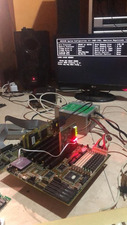BitWrangler wrote on 2022-04-01, 14:18:
marmotta wrote on 2022-04-01, 03:21:
Yes, is implied, I use 4 simm at time 😉
@bitwrangler can be a20? Is near keyboard controller? But… with 8 simm of 256k each I have 1.6mb, gate A20 work?
Right, so it's not the logical KBC or soft A20 problems but maybe physical at/near the SIMM sockets, stopping the sockets registering over a 1MB bank, or is the next address line up A21, stopping the system going higher to 4MB or higher.
Ok can be the right way! I have new details: my keyboard controller not have the pin 22 (a20 gate) connected, is managed by chipset? I found the difference from 256k and 1mb simm: the chips on 256k Simm are 16pin, on 1mb are 18 pin. One pin is for testing (I think is not useful), another is the address a9 (256k have address a0-a8, 1mb have address a0-a9). Can be useful?
The Varta poison is on some tracks, where I can reach I have tested and eventually bridged, but I not want to desolder all simm slots, if the bad track is under the sockets is a big problem...
